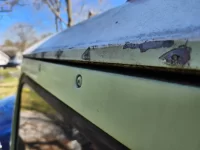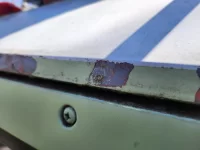P.O. apparently had an awning on the rear window and removed it at some point, leaving a dozen holes in the edge of the top rear cap. They are leaking inside of the coach. I'm looking for ideas on how to seal these holes.
I assume the correct way is to sand and fill the holes with epoxy and sand and paint. I may do that down the road, but I'm not prepared this year to do any finish painting.
The holes appear too small for me to fill with any sort of sealant, unless I were to drill them out bigger.
Thoughts and ideas welcomed.
I assume the correct way is to sand and fill the holes with epoxy and sand and paint. I may do that down the road, but I'm not prepared this year to do any finish painting.
The holes appear too small for me to fill with any sort of sealant, unless I were to drill them out bigger.
Thoughts and ideas welcomed.



